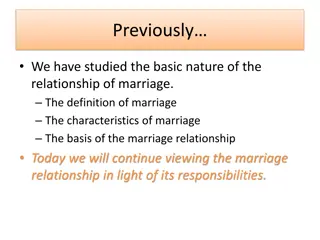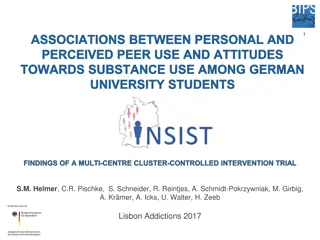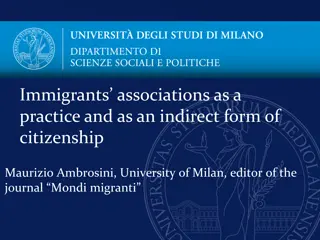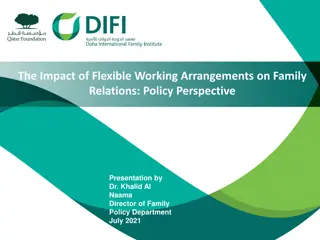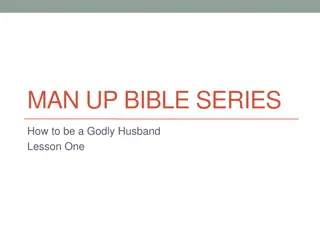Associations Between Wives and Husbands Work-Family Environment
This study explores the associations between wives and husbands in the work-family environment, focusing on the impact of supportive work environments on work-family interference and crossover effects. It discusses key constructs such as supportive work environments, work-family interference, and partners' WFI, highlighting the interconnectedness of work and family dynamics.
Download Presentation

Please find below an Image/Link to download the presentation.
The content on the website is provided AS IS for your information and personal use only. It may not be sold, licensed, or shared on other websites without obtaining consent from the author.If you encounter any issues during the download, it is possible that the publisher has removed the file from their server.
You are allowed to download the files provided on this website for personal or commercial use, subject to the condition that they are used lawfully. All files are the property of their respective owners.
The content on the website is provided AS IS for your information and personal use only. It may not be sold, licensed, or shared on other websites without obtaining consent from the author.
E N D
Presentation Transcript
The associations between wives and husbands work-family environment and work-family interference (WFI): Actor-partner interdependence models Katie M. Lawson, Ball State University Xiaoran Sun, The Pennsylvania State University Susan M. McHale, The Pennsylvania State University This work was funded by a Grant from the National Institute of Child Health and Human Development, RO1-HD32336, Susan M. McHale and Ann C. Crouter, Co-Principal Investigators.
Theoretical Background Work Work- -Home Resources Model Home Resources Model (ten Brummelhuis & Bakker, 2012) Personal resources (e.g., time, energy, mood) link work and family domains Work demands can lead to negative home outcomes by reducing personal resources Work resources can lead to positive home outcomes by increasing personal resources Employees work environments -> their own family experiences Spillover effect
Theoretical Background Family Systems Perspective Family Systems Perspective (Minuchin, 1985) Families are open systems, influenced by other contexts (e.g., work) Individuals within a family system are interdependent Employees work environments -> their spouses family experiences Crossover effect
Key constructs Supportive work Supportive work- -family environments family environments shared assumptions, beliefs, and values regarding the extent to which an organization supports and values the integration of employees work and family lives (p. 394). (Thompson et al., 1999) Work-family interference (WFI) Work demands and pressures conflict with family demands and pressures (Greenhaus & Beutell, 1985)
Work-Family Environments & WFI (Spillover) Employees perceptions of supportive work- family environments are associated with lower levels of employees reported WFI (e.g., Kossek et al., 2011, Kelly et al., 2012) Less research has focused on positive crossover to partners (Westman, 2001)
Work-Family Environments & Partners WFI (Crossover) Wives workplace family support found to predict husbands reporting lower levels of WFI (Matias et al., 2017) Research also finds that couples consciously make work decisions together to meet family demands One may pursue a career, the other a job (Becker & Moen, 1999) Couples may try to desynchronize work hour schedules (Taht & Mills, 2012)
Mechanisms Underlying Spillover A supportive work-family environment may lead to employees reduced demands at work Work hours Work pressure Fewer work hours and lower pressure predict lower levels of WFI (Byron, 2005; Grzywacz & Marks, 2000)
Mechanisms Underlying Crossover Limited research attention If complementary work patterns are determined by couples (Becker & Moen, 1999), employees supportive environment may allow their spouses to take on more work demands
Present Study Wife Work Hours (Time 1) Wife Wife Work-Family Environment (Time 1) Wife WFI (Time 2) Work Pressure (Time 1) Husband Work-Family Environment (Time 1) Husband Work Pressure (Time 1) Husband WFI (Time 2) Husband Work Hours (Time 1)
Present Study Wife Work Hours (Time 1) Wife Wife Work-Family Environment (Time 1) Wife WFI (Time 2) Work Pressure (Time 1) Husband Work-Family Environment (Time 1) Husband Work Pressure (Time 1) Husband WFI (Time 2) Husband Work Hours (Time 1)
Present Study Wife Work Hours (Time 1) Wife Wife Work-Family Environment (Time 1) Wife WFI (Time 2) Work Pressure (Time 1) Husband Work-Family Environment (Time 1) Husband Work Pressure (Time 1) Husband WFI (Time 2) Husband Work Hours (Time 1)
Present Study Wife Work Hours (Time 1) Wife Wife Work-Family Environment (Time 1) Wife WFI (Time 2) Work Pressure (Time 1) Husband Work-Family Environment (Time 1) Husband Work Pressure (Time 1) Husband WFI (Time 2) Husband Work Hours (Time 1)
Family Relationships Project Longitudinal study designed to better understand the family context of socialization First phase of data collection: 1995/96 203 two-parent families; almost exclusively European American Annual home interviews Phases 7 and 8 (referred to as Times 1 and 2) When the constructs of interest were measured N = 194 for the present study
Participants (N = 194) Wives Wives Age Education (Years) Job Prestige Husbands Husbands Age Education (Years) Job Prestige Household Household Income Time Time 1 1 43.22 (3.97) 14.60 (2.21) 50.24 (13.05) 45.53 (5.09) 14.79 (2.50) 50.44 (12.61) 75,000 (45,925)
Measures Time Time # items # items Example Item Example Item Work Work- -Family Family Environment Environment (Thompson (Thompson et al., 1999) et al., 1999) 1 20 In this organization, employees are encouraged to strike a balance between their work and family lives. Work Work Hours Hours 1 2 Hours spent working at the job and at home Work Pressure Work Pressure (Moos, 1986) (Moos, 1986) 1 9 There always seems to be an urgency about everything. WFI WFI (Small & Riley, 1990) (Small & Riley, 1990) 2 20 When I get home from work, I often do not have the energy to be a good parent.
Analyses Actor-Partner Interdependence Mediation Model (APIMeM) (Lederman, Macho, & Kenny, 2011) Structural equation modeling Lavaan package in R 3.3.2 Stepwise modeling procedure Fully saturated model first Gender moderation test Retain the more parsimonious model without significant reduction in goodness-of-fit (indicated by chi-squared test)
Results: Final Model ?2 (11) = 12.82, p = .30; RMSEA = .03; SRMR = .04; CFI = .99; TLI = .97 Good fit with the data
Results: Direct Actor Effects (Spillover) -.19 (.05)*** Wife Work Hours (Time 1) Wife Wife Work-Family Environment (Time 1) Wife WFI (Time 2) Work Pressure (Time 1) Husband Work-Family Environment (Time 1) Husband Work Pressure (Time 1) Husband WFI (Time 2) Husband Work Hours (Time 1) -.19 (.05)***
Results: Direct Partner Effects (Crossover) -.19 (.05)*** Wife Work Hours (Time 1) Wife Wife Work-Family Environment (Time 1) Wife WFI (Time 2) Work Pressure (Time 1) -.12 (.05)* -.12 (.05)* Husband Work-Family Environment (Time 1) Husband Work Pressure (Time 1) Husband WFI (Time 2) Husband Work Hours (Time 1) -.19 (.05)***
Results: Mediation (Spillover) -.19 (.05)*** Wife Work Hours (Time 1) Wife Wife .31 (.08)*** -.34 (.04)*** Work-Family Environment (Time 1) Wife WFI (Time 2) Work Pressure (Time 1) -.12 (.05)* -.12 (.05)* Husband Work-Family Environment (Time 1) Husband Work Pressure (Time 1) Husband WFI (Time 2) .31 (.08)*** -.10 (.05)* Husband Work Hours (Time 1) -.19 (.05)***
Results: Mediation (Crossover) -.19 (.05)*** Wife Work Hours (Time 1) Wife Wife .31 (.08)*** -.34 (.04)*** Work-Family Environment (Time 1) Wife WFI (Time 2) Work Pressure (Time 1) -.12 (.05)* -.12 (.05)* Husband Work-Family Environment (Time 1) Husband Work Pressure (Time 1) Husband WFI (Time 2) .31 (.08)*** -.10 (.05)* Husband Work Hours (Time 1) -.19 (.05)***
Results: Indirect Effects -.19 (.05)*** Wife B = -.06, p = .01 Work Hours (Time 1) Wife Wife .31 (.08)*** -.34 (.04)*** Work-Family Environment (Time 1) Wife WFI (Time 2) Work Pressure (Time 1) B = -.10, p < .001 -.12 (.05)* -.12 (.05)* Husband Work-Family Environment (Time 1) Husband Work Pressure (Time 1) Husband WFI (Time 2) .31 (.08)*** -.10 (.05)* Husband Work Hours (Time 1) -.19 (.05)***
Results: Indirect Effects -.19 (.05)*** Wife B = -.06, p = .01 Work Hours (Time 1) Wife Wife .31 (.08)*** -.34 (.04)*** Work-Family Environment (Time 1) Wife WFI (Time 2) Work Pressure (Time 1) B = -.10, p < .001 -.12 (.05)* -.12 (.05)* B = -.03, p = .09 Husband Work-Family Environment (Time 1) Husband Work Pressure (Time 1) Husband WFI (Time 2) .31 (.08)*** -.10 (.05)* Husband Work Hours (Time 1) -.19 (.05)***
Results: Indirect Effects -.19 (.05)*** Wife B = -.06, p = .01 Work Hours (Time 1) Wife Wife .31 (.08)*** -.34 (.04)*** Work-Family Environment (Time 1) Wife WFI (Time 2) Work Pressure (Time 1) B = -.10, p < .001 -.12 (.05)* -.12 (.05)* B = -.03, p = .09 Husband Work-Family Environment (Time 1) Husband Work Pressure (Time 1) Husband WFI (Time 2) .31 (.08)*** -.10 (.05)* B = .03, p = .08 Husband Work Hours (Time 1) -.19 (.05)***
Discussion Work-family environment has positive implications for employees and partners WFI (both spillover and crossover) (Direct effects) Did not differ by gender Underlying processes differ by gender Reduced work demands were significant mediators for women but not for men Reflecting gender norms and stereotypical gender roles May contribute to gender inequalities in career achievement Work demands did not explain the process underlying positive crossover to WFI Despite of the significant crossover from wives supportive work-family environments to husbands longer work hours Also reflecting gender roles The underlying mechanisms can be examined in the home domain instead
Thank You! Participating Families FRP Team Members NICHD (R01-HD32336)
References Becker, P. E., & Moen, P. (1999). Scaling back: Dual-earner couples' work-family strategies. Journal of Marriage and Family, 61, 995-1007. doi: 10.2307/354019 Byron, K. (2005). A meta-analytic review of work-family conflict and its antecedents. Journal of Vocational Behavior, 67(2), 169-198. Grzywacz, J. G., & Marks, N. F. (2000). Reconceptualizing the work-family interface: An ecological perspective on the correlates of positive and negative spillover between work and family. Journal of Occupational Health Psychology, 5, 111-126. doi: 10.1037/1076-8998.5.1.111 Hu, L. T., & Bentler, P. M. (1999). Cutoff criteria for fit indexes in covariance structure analysis: Conventional criteria versus new alternatives. Structural Equation Modeling, 6, 1 55. doi: 10.1080/ 10705519909540118 Kelly, E. L., Moen, P., Oakes, J. M., Fan, W., Okechukwu, C., Davis, K. D., Hammer, L., Kossek, E., King, R. B., Hanson, G., Mierzwa, Casper, L. (2014). Changing work and work-family conflict: Evidence from the Work, Family, and Health Network. American Sociological Review, 79, 485-516. Kossek, E. E., Pichler, S., Bodner, T., & Hammer, L. B. (2011). Workplace social support and work-family conflict: A meta-analysis clarifying the influence of general and work-family specific supervisor and organizational support. Personnel Psychology, 64, 289-313. Ledermann, T., & Kenny, D. A. (2017). Analyzing dyadic data with multilevel modeling versus structural equation modeling: A tale of two methods. Journal of Family Psychology, 31, 442 452. doi: 10.1037/fam0000290 Matias, M., Ferreira, T., Vieira, J., Cadima, J., Leal, T., & Matos, P. M. (2017). Workplace family support, parental satisfaction, and work-family conflict: Individual and crossover effects among dual-earner couples. Applied Psychology, 66, 628-652. doi: 10.111/apps.12103
References Minuchin, P. (1985). Families and individual development: Provocations from the field of family therapy. Child Development, 56, 289-302. Moos, R. H. (1986). Work Environment Scale manual (2nd ed.). Palo Alto, CA: Consulting Psychologists Press. Small, S. A., & Riley, D. (1990). Toward a multidimensional assessment of work spillover into family life. Journal of Marriage and Family, 52(1), 51-61. doi: 10.2307/352837 Ten Brummelhuis, L. L., & Bakker, A. B. (2012). A resourcee perspective on the work-home interface: The work-home resources model. American Psychologist, 67(7), 545-556. doi: 10.1037/a0027974 Taht, K. & Mills, M. (2012). Nonstandard work schedules, couple desynchronization, and parent- child interaction: A mixed-methods analysis. Journal of Family Issues, 33, 1054-1087. doi: 10.1177/0192513X11424260 Thompson, C. A., Beauvais, L. L., & Lyness, K. S. (1999). When work-family benefits are not enough: The influence of work-family culture on benefit utilization, organizational attachment, and work- family conflict. Journal of Vocational Behavior, 54, 392-415. Westman, M. (2001). Stress and strain crossover. Human Relations, 54, 717-751.












